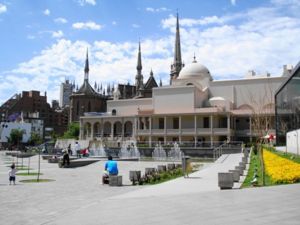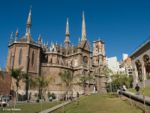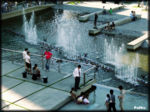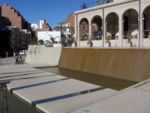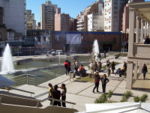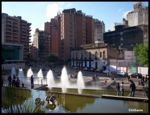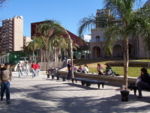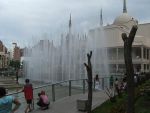Paseo del Buen Pastor
A cultural, recreational and open Space (Córdoba, Argentina)
Rationale: Why is this case study interesting?
Like an urban project located in a historical place; this innovative and provocative project conserved the cultural values revitalizing the identity by means of a new relationship between architecture and society, offering places and activities inside a space-time frame for the use of the community.
Is interesting to study how the landscape design responds to and join together the urban context, the massive daily flow of the city and the public practise of Art, defined as an alive space to Culture and Recreation.
Author's perspective
To rescue and restorate the central Chapel together with the purpose to create new spaces around these are the main aims in this project. Keep the orginal shapes and materials with a Patrimonial value combined with new materials, light structures and transparent enveloping making a clear contrast and show the time difference.
The square is open to generate a great vision of the Sagrado Corazón´s Church (also known as de los Capuchinos) with an interesting neogotic architectural style.
The big musical and illuminate fountain with dancer waters shows every hour is the face off about the original cloister and punishment destination.
With a vanguard architecture and a regional reminder on the landscape design, the project wants to make an approach to know and share the past in order to become our selfs more convinced with the Identity today.
Landscape and/or urban context
Nueva Córdoba is the home of shopping malls like Patio Olmos, big buildings, pubs, disco clubs, squares, restaurants, supermarkets and other entertainment and commercial centers. This district includes very important buildings from large companies like Motorola and Intel.
Also there are many important cultural places like Palacio Ferreyra. It is a mansion built in 1916 based on plans by the French architect, Paul Sanson. It is located at the corner of Hipólito Yrigoyen and Chacabuco, and has now been restored and adapted to house the principal art gallery of the city.
Nueva Cordoba has a number of important avenues like Yrigoyen and Velez Sarsfield. Most of the university students who come from all the country live in this neighbourhood, several buildings are being built transforming this area in the fastest-growing area of the city.
El Paseo del Buen Pastor is situated in the heart of Nueva Córdoba town, in the triangle of Av. Yrigoyen, Buenos Aires and Obispo Oro.
Cultural/social/political context
Córdoba is a city located near the geographical center of Argentina, in the foothills of the Sierras Chicas on the Suquía River, about 700 km northwest from Buenos Aires. It is the capital of Córdoba Province. Córdoba is the second most important city of the country and was founded on July 6, 1573 by Jerónimo Luis de Cabrera, who named it after Córdoba, Spain. It was one of the first Spanish colonial capitals of the region that is now Argentina. The Universidad Nacional de Córdoba is the oldest university in Argentina. It was founded in 1613 by the Jesuit Order.
Illustration: Bullet points, image, background notes
History
- How did the area/project/plan at the focus of the case study evolve?
Illustration: Table or time line
Spatial analysis of area/project/plan
- What are the main structural features?
- How has it been shaped? Were there any critical decisions?
Illustration: Map/diagram/sketches photos and background notes
Core Questions Working Group Public Space and Civic Identity
Who was involved in the participation process?
The people and organs of government involved during the planning process were:
- the architect in chief who also has a politic charge into the local Government together with a large group of young architects.
- engineers from private companies in the landscape and the technich design of the fountain.
- the Cultural Heritage Government department in Cordoba since the existing building was declared Urban Architectural Heritage into the city.
- people whom live, work and usually flow around the place.
How was the participation process implemented (methods applied)?
Several opinion polls were carried out between 2002-2003 on the local newspaper as well as to people whom often flow around the pleace. The questions on teh quiz were like "What the city needs there?" "What would you like to be there?" "what would you like to do there?" "Do you think all the building has to be destroyed?" "Do you know what happened there in the past?" these simple questions with strong meaning were asked with the intention to participate into the planning process to people belong to different social classes and also feel in any way involved with the work.
In how far does/did the project respond to people's needs?
Analysis of program/function
- What are the main functional characteristics?
- How have they been expressed or incorporated?
Illustration: Map/diagram/sketches photos and background notes
Analysis of design/planning process
- How was the area/project/plan formulated and implemented?
- Were there any important consultations/collaborations?
Illustration: Map/diagram/sketches photos and background notes
Analysis of use/users
- How is the area/project/plan used and by whom?
- Is the use changing? Are there any issues?
Illustration: Map/diagram/sketches photos and background notes
Future development directions
- How is the area/project/plan evolving?
- Are there any future goals?
Illustration: Map/diagram/sketches photos and background notes
Peer reviews or critique
- Has the area/ project/plan been reviewed by academic or professional reviewers?
- What were their main evaluations?
Pleas add references, quotes...
Points of success and limitations
- What do you see as the main points of success and limitations of the area/project/plan?
Illustration: Summary table
What can be generalized from this case study?
- Are there any important theoretical insights?
Short statement plus background notes
Which research questions does it generate?
Short statement plus background notes
Image Gallery
References
Please add literature, documentations and weblinks
About categories: You can add more categories by copying the tag and filling in your additional categories
